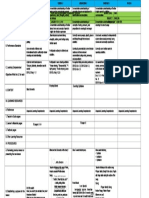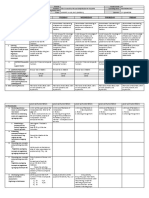Unpacking
Uploaded by
Allan Cortez PalecpecUnpacking
Uploaded by
Allan Cortez PalecpecALLAN C.
PALECPEC- CAMES
RUBY ANN APUYA-APES
RUBELYN ALCAIN- CCES
QUARTER 2- MATHEMATICS 1
LEARNING COMPETENCIES UNPACKED LEARNING COMPETENCY
1. identify simple 2-dimensional shapes (triangle, rectangle, square) of
different size and in different orientation.
2. compare and distinguish 2-dimensional shapes according to features 2a. compare and distinguish 2-dimensional shapes according to features
such as sides and corners. such as sides.
2b. compare and distinguish 2-dimensional shapes according to features
such as corners.
3. compose and decompose triangles, squares, and rectangles. 3a. compose triangles, squares, and rectangles.
3b. decompose triangles, squares, and rectangles.
4. count up to 100 (includes counting up or down from a given number
and identifying a number that is 1 more or 1 less than a given
number).
5. read and write numerals up to 100.
6. recognize and represent numbers up to 100 using a variety of
concrete and pictorial models (e.g., number line, block or bar
models, and numerals).
7. compare two numbers up to 20.
8. order numbers up to 20 from smallest to largest, and vice versa. 8a. order numbers up to 20 from smallest to largest.
8b. order numbers up to 20 from largest to smallest.
9. describe the position of objects using ordinal numbers: 1st, 2nd, 3rd,
up to 10th.
10. compose and decompose numbers up to 10 using concrete materials 10a. compose numbers up to 10 using concrete materials (e.g., 5 is 5 and 0;
(e.g., 5 is 5 and 0; 4 and 1; 3 and 2; 2 and 3; 1 and 4; 0 and 5). 4 and 1; 3 and 2; 2 and 3; 1 and 4; 0 and 5).
10b. decompose numbers up to 10 using concrete materials (e.g., 5 is 5
and 0; 4 and 1; 3 and 2; 2 and 3; 1 and 4; 0 and 5).
11. illustrate addition of numbers with sums up to 20 using a
variety of concrete and pictorial models and describes addition
as “counting up,” and “putting together.”
12. illustrate by applying the following properties of addition, using sums
up to 20:
a. the sum of zero and any number is equal to the number, and
b. changing the order of the addends does not change the sum.
13. solve problems (given orally or in pictures) involving addition
with sums up to 20.
LEARNING COMPETENCIES UNPACKED LEARNING COMPETENCY
ALLAN C. PALECPEC- CAMES
RUBY ANN APUYA-APES
RUBELYN ALCAIN- CCES
QUARTER 2- MATHEMATICS 1
1. measure the length of an object and the distance between two objects
using non-standard units.
2. compare lengths and distances using non-standard units.
3. solve problems involving lengths and distances using non-standard
units.
4. count up to 100 (includes counting up or down from a given number 4a. order numbers up to 100 from smallest to largest.
order numbers up to 100 from smallest to largest, and vice versa. 4b. order numbers up to 100 from largest to smallest.
4c. order numbers up to 100 and vice versa
5. counts by 2s, 5s and 10s up to 100. 5a. counts by 2s up to 100.
5b. counts by 5s up to 100.
5c. counts by 10s up to 100.
6. determine
a. the place value of a digit in a 2-digit number,
b. the value of a digit, and
c. the digit of a number, given its place value
7. decompose any 2-digit number into tens and ones.
8. add numbers by expressing addends as tens and ones (expanded form).
9. add numbers with sums up to 100 without regrouping, using a
variety of concrete and pictorial models for:
a. 2-digit and 1-digit numbers, and
b. 2-digit and 2-digit numbers.
10. solve problems (given orally or in pictures) involving addition with
sums up to 100 without regrouping.
You might also like
- (Ebook) Linear Algebra: Theory and Applications, 2nd Edition by Cheney ISBN 9781449613532, 1449613535 - The full ebook with complete content is ready for download100% (2)(Ebook) Linear Algebra: Theory and Applications, 2nd Edition by Cheney ISBN 9781449613532, 1449613535 - The full ebook with complete content is ready for download57 pages
- Department of Education: Simplified Melc-Based Weekly Budget of Lessons in Mtb-Mle 2No ratings yetDepartment of Education: Simplified Melc-Based Weekly Budget of Lessons in Mtb-Mle 26 pages
- Project SAGIP Individual Learning Progress Record100% (1)Project SAGIP Individual Learning Progress Record2 pages
- Lesson Guide in English Gr. 1 Using Explicit Teaching For Literacy Remediation100% (2)Lesson Guide in English Gr. 1 Using Explicit Teaching For Literacy Remediation2 pages
- DLL - Unpacking Tools-English-Grade 1 - Q3-W150% (2)DLL - Unpacking Tools-English-Grade 1 - Q3-W11 page
- LIST OF MASTERED and LEAST LEARNED SKILLSNo ratings yetLIST OF MASTERED and LEAST LEARNED SKILLS1 page
- DLP-MATH5-Q1-W9-Solves Routine and Non-Routine Problem Involving Division Without or With Any Other Operations and Whole Numbers Using Appropriate Problem Solving Strategies and Tools.No ratings yetDLP-MATH5-Q1-W9-Solves Routine and Non-Routine Problem Involving Division Without or With Any Other Operations and Whole Numbers Using Appropriate Problem Solving Strategies and Tools.3 pages
- Lesson Exemplar: (If Available, Write The Attached Enabling Competencies)No ratings yetLesson Exemplar: (If Available, Write The Attached Enabling Competencies)5 pages
- Learners Progress Report Card For The New Normal S.Y. 2021 - 2022100% (1)Learners Progress Report Card For The New Normal S.Y. 2021 - 20224 pages
- DLL - MATH 4 - Q1 - W5 - Solves Multi Step Routine and Non Routine Problems Involving Multiplication and Addition or SubtractionedumaymaylauramosNo ratings yetDLL - MATH 4 - Q1 - W5 - Solves Multi Step Routine and Non Routine Problems Involving Multiplication and Addition or Subtractionedumaymaylauramos8 pages
- Piddig South Central Elementary School: Third Quarter-Summative Test #1 Esp 1 (Week 1-2)No ratings yetPiddig South Central Elementary School: Third Quarter-Summative Test #1 Esp 1 (Week 1-2)12 pages
- Kto12 Lesson Plan School Grade 3 Teacher Subject Date/Time QuarterNo ratings yetKto12 Lesson Plan School Grade 3 Teacher Subject Date/Time Quarter7 pages
- A Narrative Report On Mental Health and Psychological Support and Services RJCC REALNo ratings yetA Narrative Report On Mental Health and Psychological Support and Services RJCC REAL1 page
- Kambal Katinig Na KR DLL - ALL SUBJECTS 2 - Q2 - W5 - D2No ratings yetKambal Katinig Na KR DLL - ALL SUBJECTS 2 - Q2 - W5 - D27 pages
- National Capital Region NCR - CRLA Division Dashboard-2No ratings yetNational Capital Region NCR - CRLA Division Dashboard-22 pages
- (Annotations) - PPST Indicators/ Kra Objectives/Rubric Indicators To Be Observed During The Demonstration100% (1)(Annotations) - PPST Indicators/ Kra Objectives/Rubric Indicators To Be Observed During The Demonstration6 pages
- Numeracy Level Numerates Nearly Numerates Non-Numerates: 1pt 1 PTNo ratings yetNumeracy Level Numerates Nearly Numerates Non-Numerates: 1pt 1 PT2 pages
- Lesson Plan Sped Non Graded COT 1 23 24 SureNo ratings yetLesson Plan Sped Non Graded COT 1 23 24 Sure5 pages
- 2020 DepEd Official Certificate TemplatesNo ratings yet2020 DepEd Official Certificate Templates4 pages
- Quarter 3 Triangle A.1 Describes The A.1 A.1 Video A.1 VideoNo ratings yetQuarter 3 Triangle A.1 Describes The A.1 A.1 Video A.1 Video18 pages
- U18Cn404 Theory of Computation: Languages and Computation, 3rd Ed. Hong Kong: Pearson Education Asia, 2007No ratings yetU18Cn404 Theory of Computation: Languages and Computation, 3rd Ed. Hong Kong: Pearson Education Asia, 20072 pages
- Completing The Square Worksheet #01, Algebra Revision From GCSE Maths TutorNo ratings yetCompleting The Square Worksheet #01, Algebra Revision From GCSE Maths Tutor2 pages
- Steve Warner , Larry Ronaldson , Deirdre Storck - SHSAT Verbal Prep Book To Improve Your Score In Two Months_ The Most Effective Strategies for Mastering Scrambled Paragraphs, Logical Reasoning and R100% (1)Steve Warner , Larry Ronaldson , Deirdre Storck - SHSAT Verbal Prep Book To Improve Your Score In Two Months_ The Most Effective Strategies for Mastering Scrambled Paragraphs, Logical Reasoning and R157 pages
- Modul Ulangkaji Matematik Form 2 NAMA: - TINGKATANNo ratings yetModul Ulangkaji Matematik Form 2 NAMA: - TINGKATAN8 pages
- Ranjan Bose Information Theory Coding and Cryptography Solution Manual89% (38)Ranjan Bose Information Theory Coding and Cryptography Solution Manual61 pages
- Download Full Basic science concepts and applications for wastewater student workbook American Waterworks Association PDF All Chapters100% (1)Download Full Basic science concepts and applications for wastewater student workbook American Waterworks Association PDF All Chapters67 pages
- Sri Vidya College of Engineering and Technology Lecture NotesNo ratings yetSri Vidya College of Engineering and Technology Lecture Notes6 pages
- Mathematics Objective Questions Part 19No ratings yetMathematics Objective Questions Part 1910 pages
- 07 - Workbook Part 2 - Business StatisticsNo ratings yet07 - Workbook Part 2 - Business Statistics158 pages

























































































